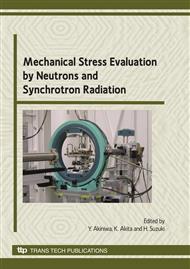p.143
p.149
p.155
p.161
p.167
p.174
p.180
p.185
p.191
Non Destructive Characterization of Phase Distribution and Residual Strain/Stress Map of Two Ancient (Koto) Age Japanese Swords
Abstract:
Two Japanese long swords (katanas) belonging to the Koto Age (X-XVI century A.D.) were measured through time of flight neutron diffraction to analyze the phases, and the stress and strain distribution, in selected parts of the blades. The swords are representative of two different forging schools (Aoe and Kanesada) and one of the main aims of the measurements was to evidence possible similarities and differences. Two independent experiments were carried out at the ISIS pulsed neutron source using the INES and ENGIN-X diffractometers. The former was employed to map the average phase distribution on two selected cross sections, of each blade, distinguishing among the ridge, the core, and the edge of the blades. In this way, we were able to quantify the coarse distribution of the carbon content and, moreover, we could evidence the presence of martensite. These data were then complemented measuring detailed stress and strain distribution maps on ENGIN-X. As far as the ridge and the core are concerned, the tang data were taken as a reference. These measurements significantly improve the knowledge and understanding of the technology used to produce Japanese swords belonging to the Koto Age.
Info:
Periodical:
Pages:
167-173
Citation:
Online since:
May 2010
Price:
Сopyright:
© 2010 Trans Tech Publications Ltd. All Rights Reserved
Share:
Citation:


